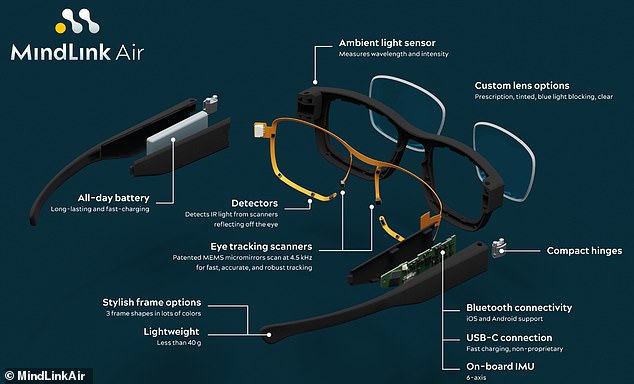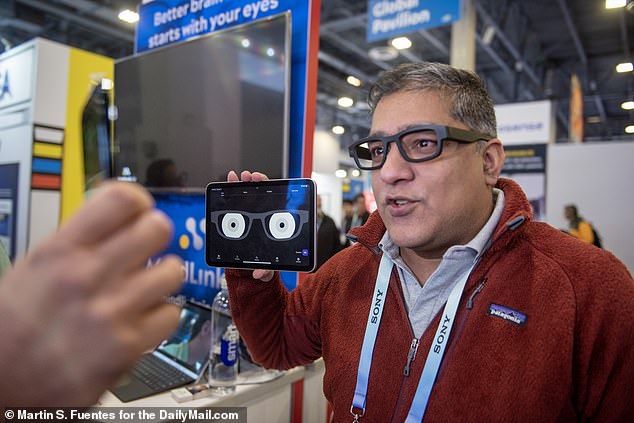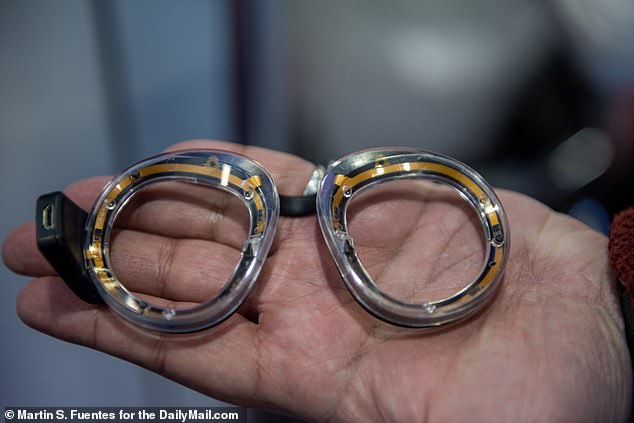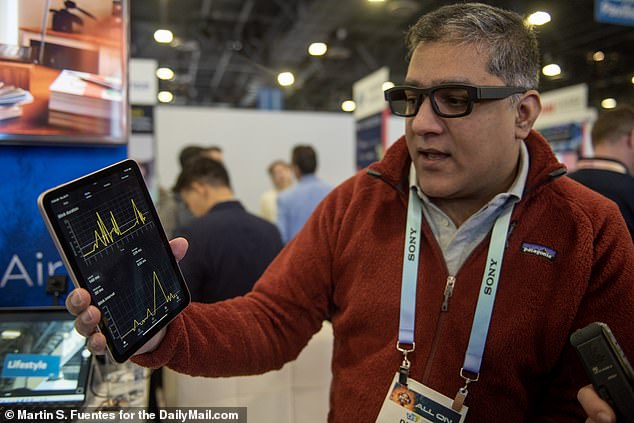Smart glasses that peer into your BRAIN while you work help achieve the elusive ‘flow state’ unveiled at CES
A new wearable debuted at CES in Las Vegas, but unlike wrist-worn wearables that track steps, this device goes on your face and tracks brain function.
The wearable, called MindLink Air, is a pair of glasses that claim to do just that optimize the user’s attention throughout the day and maximize the time spent in an intensely focused ‘flow state’.
The intangible state produces a feeling of ecstasy when an individual is fully immersed in a task or activity, allowing them to fully concentrate on that moment – but scientists have yet to understand the experience.
While MindLink Air is designed to increase attention, the company believes its eye-tracking technology can also help detect early signs of brain diseases.
Several studies have found that eye movements can slow as cognitive decline increases, and the company believes its $600 wearable can detect these subtle changes after just a few months of use.
MindLink Air is a pair of glasses that claims to optimize the user’s attention throughout the day and maximize the time spent in an intensely focused ‘flow state’.
Neil Sarkar, CEO of MindLink Air, told DailyMail.com: ‘The sooner you can detect it, the more likely it is that preventative measures will actually work.’
Sakar said the glasses can detect small changes in your eyes over months and years of use and raise early alarms about dementia, seizures or other brain disorders.
For example, if your eyes linger on words for 15 milliseconds longer while you read, this could be a very early warning sign of cognitive decline.
MindLink Air achieves this by mapping and tracking your eyes with six sensors while you wear the glasses.

While MindLink Air is designed to increase attention, the company believes its eye-tracking technology can also help detect early signs of brain diseases.

Neil Sarkar, CEO of MindLink Air (pictured) told DailyMail.com that the glasses can detect small changes in your eyes over months and years of use and raise early alarms about dementia, seizures or other brain conditions.
And because these sensors are behind the lenses, you can wear any lens – prescription, sunglasses or whatever – without any interference.
The eyes are a great way to monitor the brain, Sarkar said, because our eyes have a direct line to our brain. Two even: the optic nerves.
This is why a doctor will check your eyes after you suffer a head injury, or check your pupils if you become unconscious: the eyes provide insight into how the brain works.
But it’s not just breathing and reflexes that the eyes can convey.
“It turns out that you can also measure higher-order brain responses, such as cognitive load, fatigue and focus,” says Sarkar.
The way they do it is with infrared light and small light sensors.
While you wear the glasses, an infrared light beam passes over your eyes many times per second.

“It turns out you can also measure higher-order brain responses, such as cognitive load, fatigue and focus,” Sarkar said. The way they do it is with infrared light and small light sensors

The glasses’ accompanying app will coach users in optimizing focus and minimizing risks
This light reflects through your eye and is captured by the detectors in the glass frames.
These detectors make the MindLink Air possible, Sarkar said.
The device has a diameter of 300 micrometers and is thinner than human hair, so it fits in a glasses frame.
The detectors capture a 3D model of the eye and all its behavior: pupil dilation and contraction; the distance and speed of lateral movements; flash length and frequency; and vergence, how crossed your eyes are.
Taken together, these measures provide a wealth of data for Sarkar and colleagues to look for patterns and insights.
For example, the length of your blinks may subtly but noticeably lengthen as you spend more time on a task.
Such small changes may be difficult to notice, but the glasses will pick them up.
Maybe you get tired. And maybe this will help you understand how long you should try to concentrate at a time. Or perhaps at which times of the day you are sharpest.

Because these sensors are behind the lenses, you can wear any lens – prescription, sunglasses or whatever – without any interference. These detectors make the MindLink Air possible, Sarkar said. The device has a diameter of 300 micrometers and is thinner than human hair, so it fits in a glasses frame
Either way, working while fatigued can increase your risk of burnout – the opposite of a flow state.
The glasses’ accompanying app will coach users in optimizing focus and minimizing risks.
The degree of convergence can provide some immediate memories. Because we look at each other more when something is closer, and we spend longer periods of time with our eyes slightly crossed, MindLink Air can see that.
“If you’re looking at something very close and the text you’re reading is small, it’s better to take 20 seconds in 20 minutes to look at something 20 feet away,” Sarkar said.
Most of the eye movements the device measures are simple, but the differences it detects are so small that there is no low-tech way to do this.
A slightly more complicated measure has to do with lateral movement. Usually, the further we shift our focus laterally, the faster we do it.
So when we read and move from word to word, we go slowly. And if we finish a line and go back to the left side of the page, we’ll do that faster.
But if we shift gears slowly over a long distance, or quickly over a short distance, it could be a sign that you’re not as alert, Sarkar said.
Normally you’d need research-grade laboratory equipment to capture that change, but MindLink Air will record it as you drive to work and at any other time of the day.
By recording throughout the day, MindLink Air can establish a baseline for you and determine what it can ‘expect’ from you on a daily basis, so that if anything is different, the glasses will pick up on it.
The purpose of this would be to change your behavior.
If you are not alert while driving or at work, you can take a rest. If you’re extra alert between certain hours, you may want to put your phone on silent at that time so you won’t be disturbed while you’re in the zone.
MindLink will launch a Kickstarter in March, with the glasses shipping in the second half of the year – and customers will get a 50 percent discount on the campaign’s funding.
